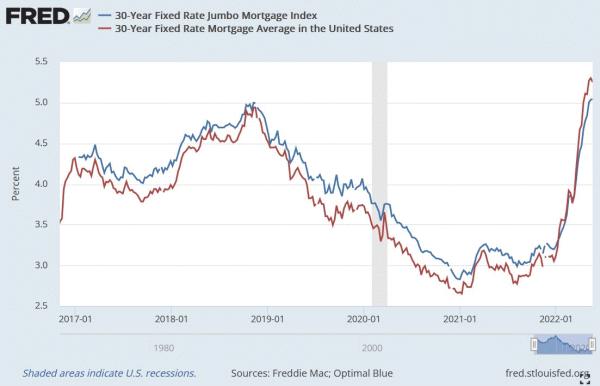
Lumber futures prices peaked at $1,670 per 1,000 board feet back on May 7, 2021. This is relevant because lumber prices tend to lead a lot of housing-related data series by about a year.
This week's chart looks at the Case-Shiller U.S. National Home Price Index, which is a measure of the changes in average U.S. home values. That is a tough data series to compute, because they have to use home sales to figure out what homes are worth, and the buying and selling of houses is subject to a bunch of confounding factors. So no one should assume that it is a perfectly accurate representation of all real estate prices everywhere. And your mileage may vary.
Before zooming up to that May 2021 peak at $1,670, lumber futures prices bottomed $263 per 1,000 board feet on April 2, 2020. So it was a pretty impressive swoop upward, and the lumber mills assuredly enjoyed the additional profit margins, assuming that they could get workers in to mill that lumber under the COVID restrictions.
Now that lumber futures prices are falling back down to reality at a price of $665 per 1,000 board feet, no one is envying the mill owners. Demand has not met those wild expectations of a year ago. This has importance for more people than just those mill owners, as lumber prices serve as a leading indication for a variety of housing data, including housing starts, home sales, and home prices. One year seems to be the magic lookback period, and I really do not understand why that is the magical time period. I just see that it works when we compare the data series.
The falling off of demand for lumber suggests that we will see a falling off of demand for housing generally, after factoring the one-year lag. Recessions and layoffs have a tendency to do that, and we are likely to see more signs of both starting to appear over the next few weeks. The plot of the Case-Shiller Index is NOT likely to exactly match the plot of lumber futures, because the effects of the COVID Crash are evident in lumber prices in ways that will probably not show up later in the home price data. Exogenous events like that tend not to get fully echoed in the following data series.
But a drop off in lumber demand does suggest that housing prices are likely to moderate over the next year or so. The 19.8% annualized rate of growth from February 2021 to February 2022 (the most recent data available) is not a sustainable rate of rise, especially as the supply chain worries bring a natural slowdown in economic activity. This is especially so in an environment where mortgage rates have jumped up from below 3% to now around 5%. That is going to take away the ability of a lot of home buyers to afford the payments on the higher-priced homes, and put a big lid on home price appreciation.
There is also a peculiar phenomenon in the mortgage market right now, in which conventional 30-year mortgages are now at a higher interest rate than "jumbo" mortgages.

Historically, the jumbo loans have commanded a higher mortgage rate, because of the perception that a more expensive house would be more difficult for a bank to dispose of in foreclosure. I happened to meet a senior loan officer this week, and I asked him about this anomaly. He explained that the buyers of the mortgage-backed securities (MBS) tied to each type of load are different entities, which explains part of this difference arising in 2022. He also noted that the threshold for a "jumbo" mortgage has not been rising as much as the change in the median home sale price, and so a lot more home mortgages are falling into the jumbo category. This is leading purchasers of this mortgage debt to conclude that perhaps the jumbos are now representing LESS risk to hold, because the difficulty of unloading such properties in foreclosure is now less, and the borrowers buying these homes may now actually be a better credit risk. This suggests a big disruption is forming in the "starter home" segment of the real estate market.
